Partners
North Carolina State University
Stanford University Institute for Economic Policy Research
University of Pennsylvania Wharton School of Business
Summary
Research conducted to understand the benefits of financial itinerary education for low- to moderate-income (LMI) adults, for those experiencing poverty dynamics, and those identified as vulnerable groups. Research areas focused on household savings, personal finance, financial distress, private pensions, and financial resilience.
Overview

Grant Duration
Phase 1: September 1, 2019 to February 31, 2024
Phase II: Sept 2023 to Sept 2026
Phase 1
In the summer of 2019, the Institute of Consumer Money Management awarded a four-year grant to North Carolina State University with Robert Clark as the Principal Investigator. The research team included co-PIs Annamaria Lusardi of George Washington University (and since September 2023, Stanford University) and Olivia S. Mitchell of the University of Pennsylvania. The proposed research consisted of two nationally representative surveys of individuals aged 45 to 75, examination of five important research areas, and a capstone conference.
Using some carry-over funds, the research team conducted a third survey and built a longitudinal data set consisting of 2,279 respondents who were interviewed each year between 2020 and 2022.
New Initiatives
Based on our strategic model of bridging research and practice, we have initiated a new RFP to engage a field expert who will analyze the Tri-State research papers, with a specific emphasis on translating foundational findings into practical solutions. We funded Boston College’s Center for Retirement Research to translate these findings into applied work and policy changes.
ICMM is also working with NCSU’s Poole College faculty to create a pilot program providing financial education to North Carolina municipal employees who have low to moderate incomes. This program will begin in 2025.
Research Studies
The proposal identified five areas of research that would be conducted during this project. During Phase 1 of the grant, Tri-University completed a ICMM-supported Capstone Conference & 16 Presentations based on ICMM-supported Grant Research. They also published nine articles related to this research.
Research Area 1
How do transitions from work to retirement affect the wellbeing of LMI households?
This research project documented and explained how the income of older Americans changed as they approached retirement, left the labor force, and lived during their retirement years. One paper examines entry rates into and exit rates from poverty.
Income Trajectories in Later Life: Longitudinal Evidence from the Health and Retirement Study
Olivia Mitchell, Robert Clark, and Annamaria Lusardi, “Income Trajectories in Later Life: Longitudinal Evidence from the Health and Retirement Study,” Journal of the Economics of Ageing, 22, June 2022.
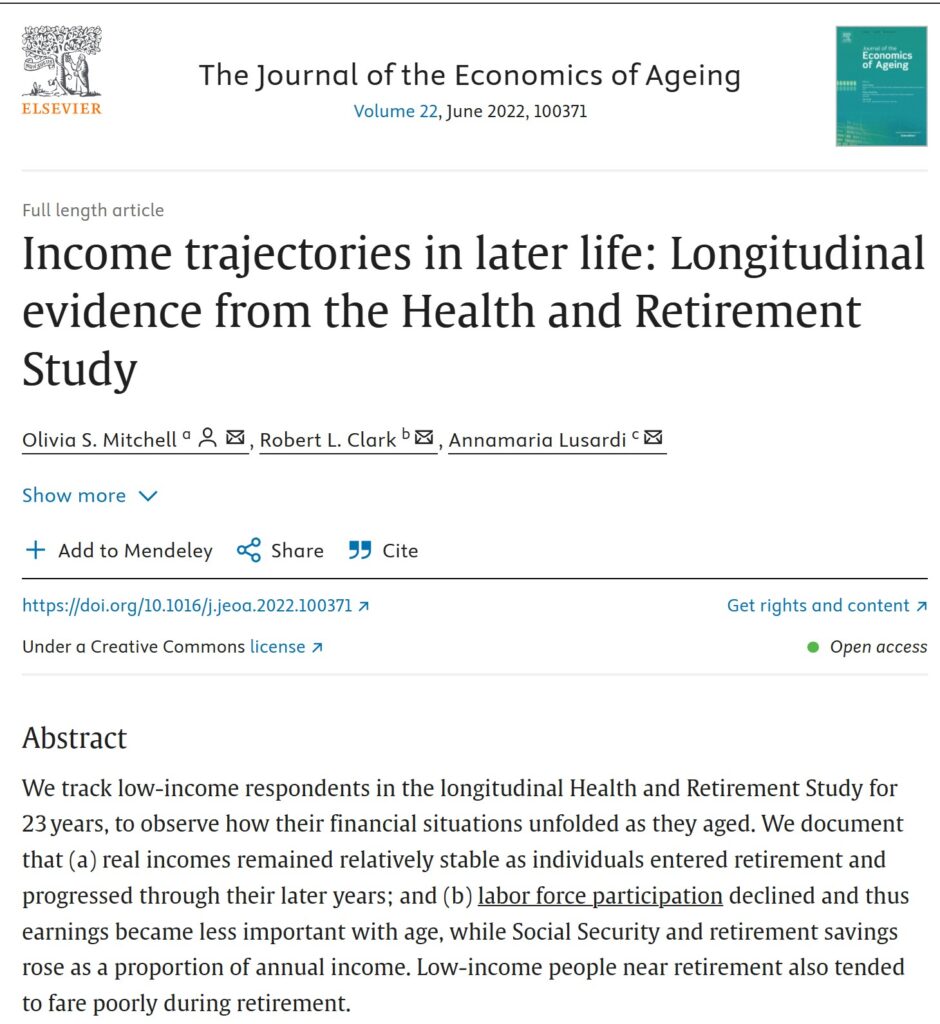
The analysis tracks low-income respondents in the longitudinal Health and Retirement Study for 23 years, to observe how their financial situations unfolded as they aged. We document that (a) real incomes remained relatively stable as individuals entered retirement and progressed through their later years; and (b) labor force participation declined and thus earnings became less important with age, while Social Security and retirement savings rose as a proportion of annual income. Low-income people near retirement also tended to fare poorly during retirement.
A Competing Risk Analysis of Older Americans’ Poverty Entry and Exit Patterns in the Health and Retirement Study
Robert Clark, Annamaria Lusardi, and Olivia Mitchell, “A Competing Risk Analysis of Older Americans’ Poverty Entry and Exit Patterns in the Health and Retirement Study,” 19, August 2024. Available at SSRN.

Poverty among older persons is not a static or permanent state; rather, older people move into and out of poverty just as do younger individuals. We document key factors associated with poverty entry and exit patterns at older ages using a longitudinal dataset from the Health and Retirement Study over the period 2002-2018. We show that modeling and accounting for nonrandom sample attrition due to the competing risks of death and loss to follow-up result in somewhat different results, compared to a hazard model that ignores these risks. Analysts using panel data seeking to understand retirement security at older ages would do well to investigate how attrition shapes empirical estimates. The Social Security Bulletin is the official journal of the Social Security Administration.
Research Area 2
Factors driving financial wellbeing among Black and Hispanic women
This research project showed how the economic wellbeing of Black and Hispanic women changed during recent years and what factors were the main drivers affecting the variation across households. While only one paper is listed under this project, all of the papers listed in this report carefully examine differences by race and ethnicity.
Factors Contributing to Financial Wellbeing among Black and Hispanic Women
Robert Clark, Annamaria Lusardi, Olivia Mitchell, and Hallie Davis. “Factors Contributing to Financial Well-being among Black and Hispanic Women (PDF), “Journal of Retirement, Summer 2021, 9(1): 71-97.
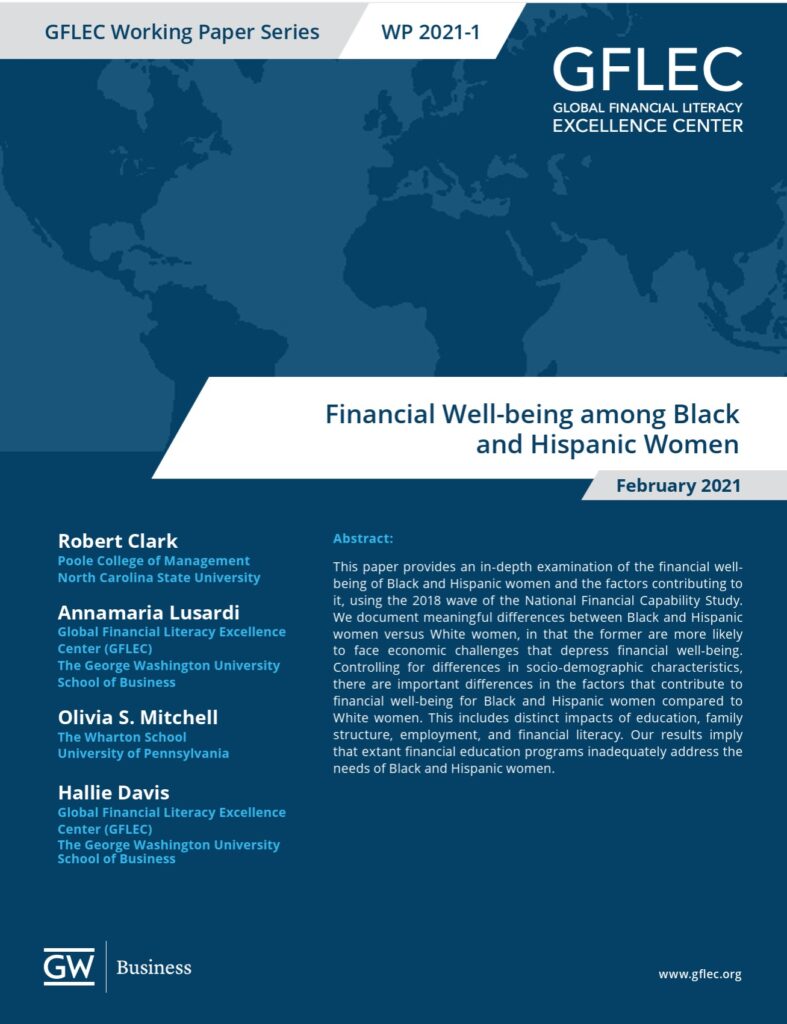
This article provides an in-depth examination of the financial wellbeing of Black and Hispanic women and the factors contributing to that wellbeing, using the 2018 survey wave of the National Financial Capability Study. The article documents meaningful differences between Black and Hispanic women versus White women; the former are more likely to face economic challenges that depress financial wellbeing. Controlling for differences in sociodemographic characteristics, important dissimilarities distinguish the factors that contribute to financial wellbeing for Black and Hispanic women compared to White women—including the distinct impacts of education, family structure, employment, and financial literacy. The results imply that extant financial education programs inadequately address the needs of Black and Hispanic women.
Research Area 3
Trends in LMI household income during retirement
The research under this project focused on how older Americans were affected by the health pandemic and the resulting economic shocks. A specific focus of the research was how households prepared for adverse economic events.We created a resilience index, showed that resilience affected key economic decisions and that respondent scores on this index was stable over time.
Financial Fragility during the Covid-19 Pandemic
Robert Clark, Annamaria Lusardi, and Olivia Mitchell, “Financial Fragility during the COVID-19 Pandemic,” American Economic Review Papers and Proceedings, May 2021, 111: 292-296.
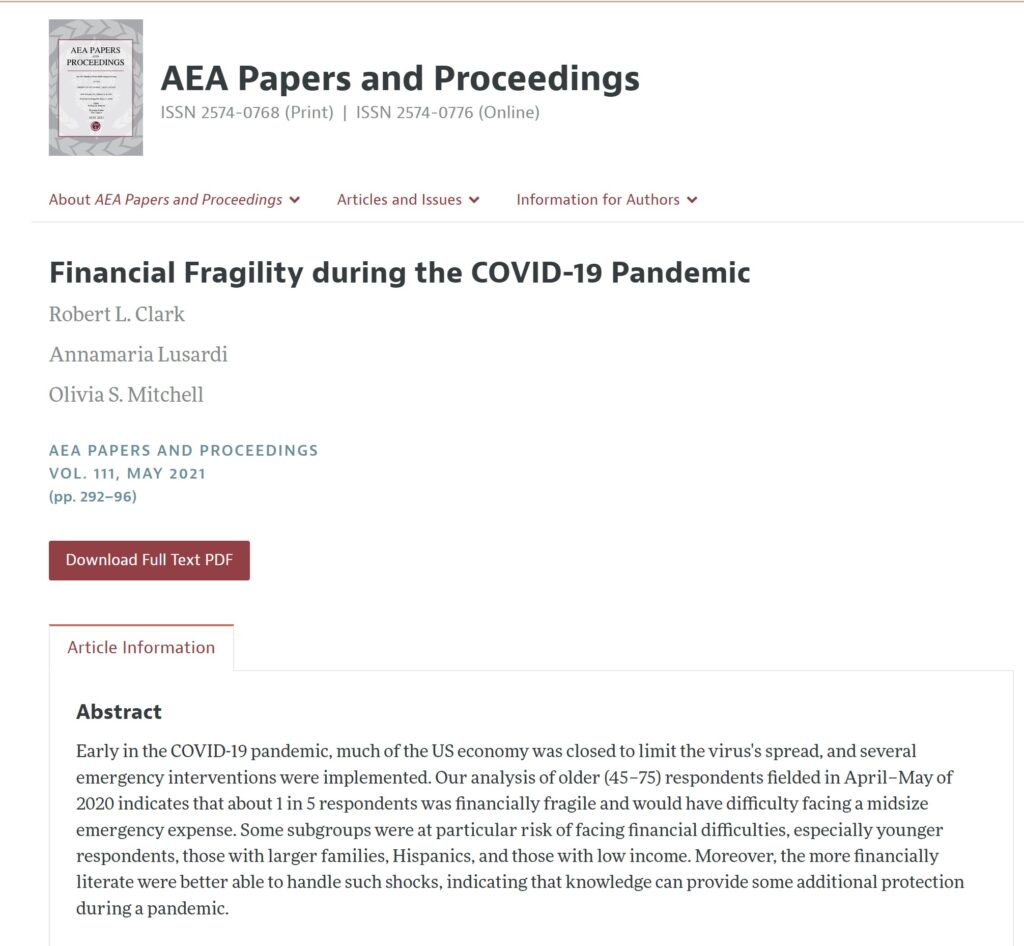
Early in the COVID-19 pandemic, much of the US economy was closed to limit the virus’s spread, and several emergency interventions were implemented. Our analysis of older (45–75) respondents fielded in April–May of 2020 indicates that about 1 in 5 respondents was financially fragile and would have difficulty facing a midsize emergency expense. Some subgroups were at particular risk of facing financial difficulties, especially younger respondents, those with larger families, Hispanics, and those with low income. Moreover, the more financially literate were better able to handle such shocks, indicating that knowledge can provide some additional protection during a pandemic. The American Economic Review is the premier journal of the American Economic Association. The Papers and Proceedings issue includes papers that were presented at the annual meeting of the Association.
American’s Financial Resilience during the Pandemic
Robert Clark and Olivia Mitchell, “American’s Financial Resilience during the Pandemic,” Financial Planning Review, June-September, 2022, 5(2-3): 1-15.
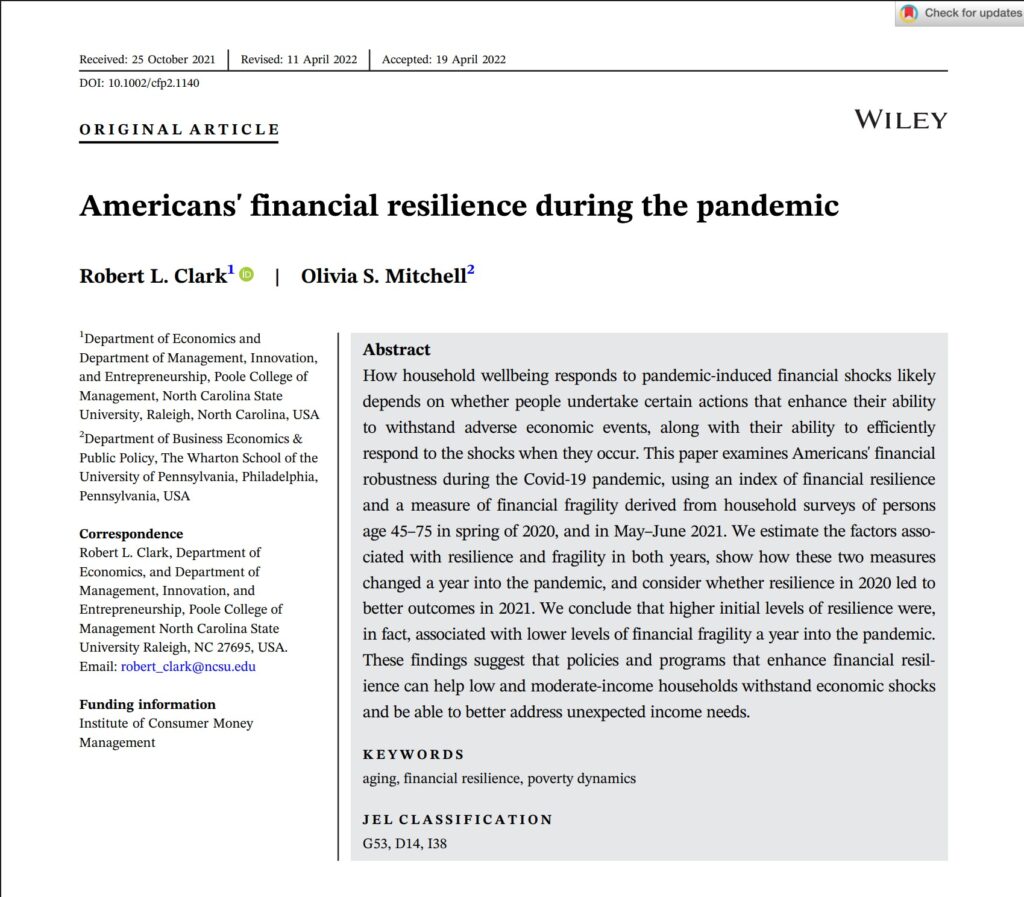
How household wellbeing responds to pandemic-induced financial shocks likely depends on whether people undertake certain actions that enhance their ability to withstand adverse economic events, along with their ability to efficiently respond to the shocks when they occur.
This paper examines Americans’ financial robustness during the COVID-19 pandemic, using an index of financial resilience and a measure of financial fragility derived from household surveys of persons age 45–75 in spring of 2020, and in May–June 2021. We estimate the factors associated with resilience and fragility in both years, show how these two measures changed a year into the pandemic, and consider whether resilience in 2020 led to better outcomes in 2021. We conclude that higher initial levels of resilience were, in fact, associated with lower levels of financial fragility a year into the pandemic. These findings suggest that policies and programs that enhance financial resilience can help low- and moderate-income households withstand economic shocks and be able to better address unexpected income needs. The Financial Planning Review has a large readership among practicing HR and benefit managers.
Financial Fragility, Financial Resilience, and Pensions Distributions
Robert Clark and Olivia Mitchell, “Financial Fragility, Financial Resilience, and Pension Distributions,” Journal of Retirement, forthcoming, May 2024.
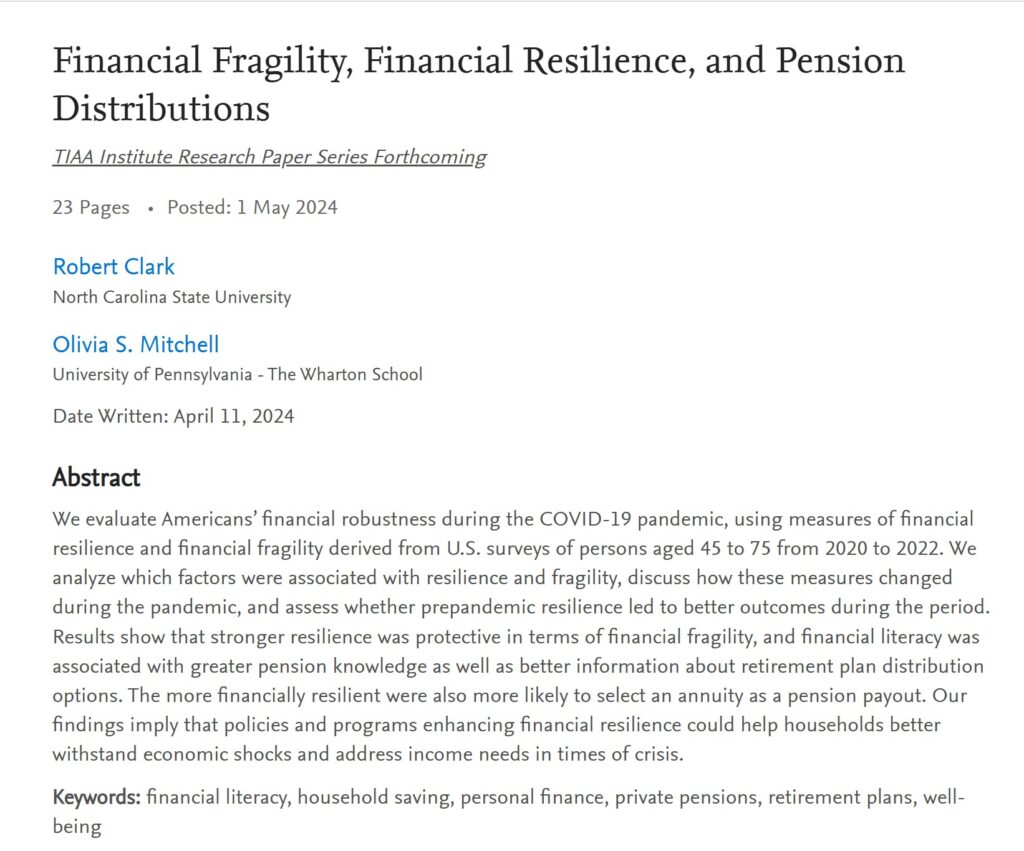
We evaluate Americans’ financial robustness during the COVID-19 pandemic, using measures of financial resilience and financial fragility derived from US surveys of persons age 45-75 from 2020 to 2022. We analyze which factors were associated with resilience and fragility, discuss how these measures changed during the pandemic, and assess whether pre-pandemic resilience led to better outcomes during the period. Results show that stronger resilience was protective in terms of financial fragility, and financial literacy was associated with greater pension knowledge as well as better information about retirement plan distribution options. The more financially resilient were also more likely to select an annuity as a pension payout. Our findings imply that policies and programs enhancing financial resilience could help households better withstand economic shocks and address income needs in times of crisis. The Journal of Retirement has a large readership of professional economists, HR managers, and benefits specialists.
Research Area 4
Distribution choices from retirement plans
One of the most important decisions older Americans must make at retirement concerns how they access their pension wealth. Only a few studies have examined the distribution choices from pension plans. The primary choice is between selecting an annuity or taking a lump sum distribution. Our research investigates the drivers of this choice.
Influencing the Choice of Pension Distribution at Retirement
Robert Clark and Olivia Mitchell, “Influencing the Choice of Pension Distribution at Retirement,” Journal of Pension Economics and Finance, 2024, 23(1): 72-88.

Pension plan participants must decide how they will access their pension assets when they terminate employment with their plan sponsors. Their choices can affect their financial wellbeing in retirement, and they depend both on their own preferences and the options offered by their retirement plans.
This paper examines both past and future pension withdrawal choices for those with defined benefit (DB) and defined contribution (DC) pensions, as well as those having both. Our data are drawn from the pension distribution questions we fielded in the Understanding American Study. Results show significant differences in distribution choices based on the type of retirement plan, with individuals covered by DB plans significantly more likely to select annuities compared to similar employees covered by DC plans. We also find differences in how higher annual income affects annuity choices based on coverage by DB plans. Individuals with lower levels of financial literacy and lower annual income have less knowledge of basic pension characteristics.
An Analysis of Benefit Distribution Options Selected by Individuals Covered by the PBGC
Robert Clark, Denis Pellitier, and Beth Ritter, “An Analysis of Benefit Distribution Options Selected by Individuals Covered by the PBGC,” currently under review.
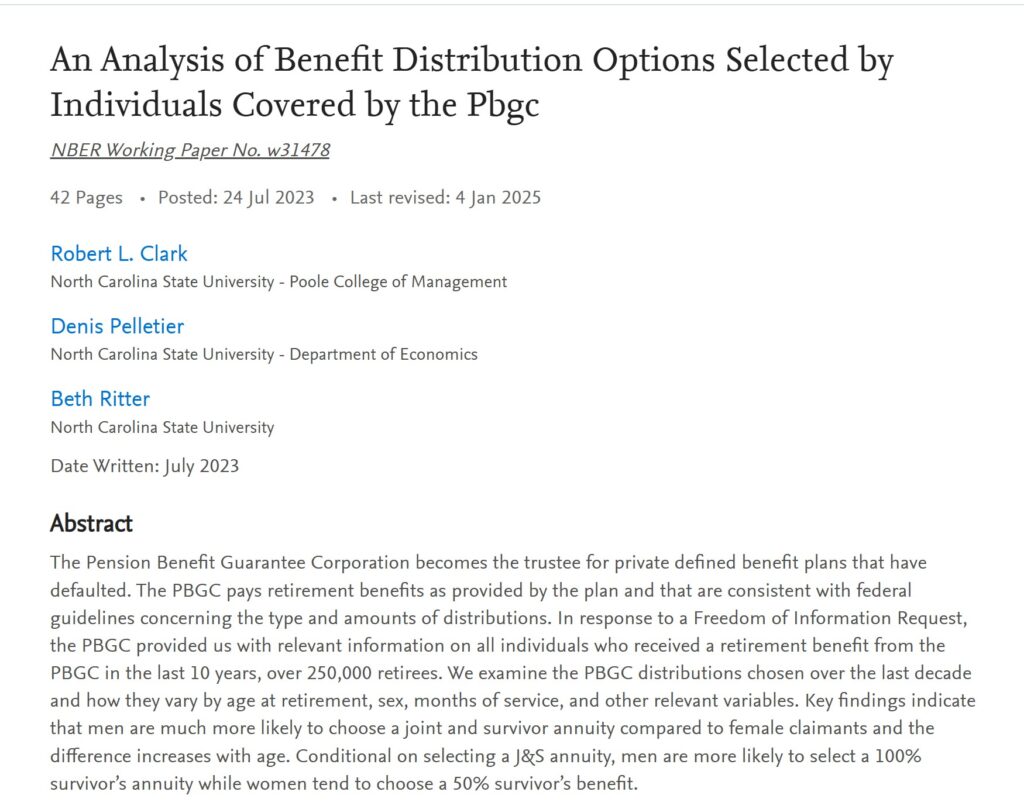
The Pension Benefit Guaranty Corporation is the trustee for private defined benefit plans that have defaulted. The PBGC pays retirement benefits as provided by the plan and are consistent with federal guidelines. The PBGC provided us with relevant information on all individuals who received a benefit in the last 10 years, over 250,000 retirees. We examine the PBGC distributions chosen and how they vary by age at retirement, sex, months of service, and other relevant variables. Findings indicate that men are much more likely to choose a joint and survivor annuity compared to women and the difference increases with age.
Research Area 5
Evaluating the effectiveness of behaviorally-informed financial education programs
Surveys in this project focused on the effect of low-cost financial education programs on financial literacy and economic decisions. Our results provide evidence that even short and low-cost financial education interventions can improve people’s financial knowledge, providing evidence in support of financial education programs.
Evaluating the Effects of Low-Cost, Online Financial Education Program
Robert Clark, Chuanhao Lin, Annamaria Lusardi, Olivia Mitchell, and Andrea Sticha, “Evaluating the Effects of a Low-Cost, Online Financial Education Program (PDF),” released as a working paper, being revised for submission to an appropriate journal.

This paper provides evidence on how a low-cost, online, and scalable financial education program influences older participants’ financial knowledge. We tested the program using a field experiment that included short stories covering three fundamental financial education topics: compound interest, risk diversification, and inflation. Two surveys were administered eight months apart to measure the effects of those stories on participants’ short-term and longer-term knowledge and financial distress indicators. We show that the risk diversification story was the most effective at improving participants’ knowledge, in both the short and longer term. The compound interest and inflation stories significantly increased participants’ knowledge in the short term, but the gain in financial literacy declined over time.
Phase II (2023-2026)
In 2023, the ICMM funded a second phase of research to continue funding work related to retirement and savings decisions, as well as providing interventions to help educate on basic financial concepts, such as inflation, risk diversification, and interest. A third, nationally representative survey was conducted to study the effects of detailed stories used to illustrate various financial concepts, such as interest, on financial literacy scores. Two new research papers have originated from this second phase of work.


